#Duchy of Warsaw
Explore tagged Tumblr posts
Text

Duchy of Warsaw :3
I keep forgetting about my TUMBLR AAHFUHUGH
73 notes
·
View notes
Text

Talleyrand and Napoleon,,,, thinking about this 1811 painting of them
Painting (detail) by Marcello Bacciarelli, c. 1811, “Granting of the Constitution of the Duchy of Warsaw by Napoleon, 22 July 1807���
#Talleyrand#Napoleon#Marcello Bacciarelli#duchy of Warsaw#Poland#napoleonic#napoleonic era#napoleon bonaparte#first french empire#french empire#19th century#Bacciarelli#painting#detail#history#france
45 notes
·
View notes
Text

Look at my Napoleonic horror author….
#Jan Potocki#Potocki#The Manuscript Found in Saragossa#napoleonic#history#french literature#polish literature#Poland#early 19th century#19th century literature#duchy of Warsaw#werewolf#werewolves#lycanthropy#fairytales#wikipedia#my posts#napoleonic era
35 notes
·
View notes
Text

Meanwhile in vatnik clownland…. According to the eloquent words of this eminent Russian historian, Poland has only existed since 1918.
However, back in the real world, this is yet another Russian lie, because Poland actually came into existence nearly a thousand years before that - in the year 966 to be precise.
Poland's name is derived from that of a West Slavic tribe - the Polanie ("people of the fields") - who settled in Central Europe in the 6th century. On 14th April 966, Mieszko I, the ruler of the Polanie, accepted Christianity through the auspices of the Roman Church and this is generally accepted by real historians as the founding event of the Polish state.
In 1025 Poland became a kingdom, which later united with the Grand Duchy of Lithuania in 1386. Nearly two centuries later, in 1569, the Union of Lublin formally established the Polish–Lithuanian Commonwealth, a huge multi-ethnic state which was regarded as one of Europe's great powers at the time. A century later the Commonwealth began a spiral of decline which led to its eventual demise at the end of the 18th century, when it was taken apart by its neighbours - Prussia, Austria-Hungary and Russia.
The first attempt to resurrect a Polish state was the creation of the Duchy of Warsaw in 1807 by Napoleon, which only lasted a few years before disappearing from the map again after Napoleon's defeat in the east. Uprisings in 1830 and 1863 were also brutally suppressed.
However, the Polish people never lost their sense of identity, and despite attempts to germanise and russify them, preserved and passed on their language and culture from one generation to the next until Poland finally regained its independence in 1918, with the creation of the Second Polish Republic, which established and successfully defended its borders over the next two years after victorious conflicts with Germany and Soviet Russia.
In 1939, Poland was invaded and partitioned once again - by Nazi Germany and the USSR - and remained under Soviet occupation until 1989, when communist rule was peacefully overthrown and Poland once again re-established itself as a democratic state, initiating the collapse of the Soviet bloc….
#poland#polish-lithuanian commonwealth#partitions of poland#duchy of warsaw#history#first world war#independence#polish-soviet war#silesian uprisings#second world war#soviet bloc#russia#vatnik#vatnik clownland#bad history take#bad history takes
4 notes
·
View notes
Text

Grand Duchy of Warsaw.
10 notes
·
View notes
Text
Prince Poniatowski in Kraków, in spring 1813
Today let’s switch back o the topic of prince Józef’s last year. The Polish Army under his command entered Kraków in the end of February, 1813:

(all the drawing by the Polish painter Zbigniew Łoskot)
What was prince Józef doing then? Well, his main task as a commander was to rebuild the Army. New conscripts had been taken already in Warsaw, in Kraków there joined the locals, the Krakuses, on their ‘short’ horses. The maneuvers would take place on Błonia meadow west of the city, sometimes general Poniatowski would attend them.
Krakusi:

In addition to his military duties prince Poniatowski had to participated in the social life. The ministers of the Duchy had moved to Kraków together with the army; a lot of Varsovians, fearing the Russians, had evacuated from the capital as well.
Holidays, such as Easter, the Birthday of Napoleon’s son, the King Rome, prince Józef’s name day, were celebrated with great pomp.

And though the carnival was already over, people were in such a need of fun that dances would often take place.

Prince Józef had to participate in such activities as well, even if he wasn’t in a mood of having fun.
Because the citation was becoming more and more serious. The garrisons of some Polish fortress were capitulating; general Frimont, the commader of the Austrian corps, which theoretically was an allied one, would push general Poniatowski and his men to leave; Napoleon was rebuilding his army and didn’t hasten to come from France; and, in addition, Poniatowski’s friends and relatives were ‘defecting’ and persuading him to join them, to betray Napoleon and enter the service of the coalition.
One of those men was Konstanty Czartoryski, prince Józef’s second cousin (and the younger brother of prince Adam, a friend of the Russian tsar Alexander):

Another - prince Antoni Radziwiłł, married to a princess from the Hohenzollern dynasty, a first cousin one removed of the Prussian king.
(The meeting with Radziwiłł, however, turned out to be a very short one, because on arriving the latter was arrested by the order of the French ambassador in the Duchy, Edouard Bignon, and Poniatowski managed to free the unlucky visitor only on condition he would immediately leave Kraków)

But prince Józef didn’t give in.
The hardest moment happened in night from 6th to the 7th of May, on the eve of his 50th birthday. The emotional tension was so strong, that prince Józef was even thinking of committing suicide. Twice. (More on the topic I wrote here, in the post about Poniatowski’s relations with Napoleon).
But eventually he made a decision to stay with the Emperor of the French, what he announced next morning, revealing some details of his night thought, to another of his pals trying to persuade him, the count Aleksander Linowski:

And the next day the first divisions of the Polish Army started to move west, to join Napoleon in Germany.

#Poniatowski#józef poniatowski#1813#kraków#Zbigniew Łoskot#Konstanty Czartoryski#Antoni Radziwiłł#Aleksander Linowski#the duchy of warsaw#Napoleonic#Napoleonic Wars
25 notes
·
View notes
Text
zamek Czersk





#poland#polska#zamek#czersk#mazowsze#mazowieckie#castle#medieval#prince#duke#chamber#masovia#duchy#history#warsaw#warszawa
0 notes
Text


Um hi again
Jayvik but G&BP. Viktor is part of Duchy of Warsaw (Poland) and Jayce is US Marines
twit: @CoeurDeLuciole
#roblox#roblox art#jayvik#arcane#jayce talis#viktor arcane#napoleonic wars#napoleonic era#if u know me from twitter know u don’t#my artwork#league of legends#jayce x viktor
179 notes
·
View notes
Text
Night at the Museum: Redesigning Characters (Bonus)
Character profile: Napoléon "Le Petit Caporal" Bonaparte
This character is based off of and takes inspiration from the historical Napoleon Bonaparte.
Real Name: Napoléon Bonaparte
Nickname and Meaning: Le Petit Caporal - A term of affection from his soldiers
Age: 40-41 (Late 1809, early 1810)
Time Period: Napoléonic era frace
Family: Josephine de Beauharnais (ex-wife), Marie Louise (wife)+ seven siblings none of which were brought back besides Louis-Napoléon Bonaparte- his nephew

(Headcanons under the cut)
Based on/taken from History:
Pompous
Very overly confident.
Egotistical. He hasn’t seen his own downfall yet and feels he can win more.
On December 2, 1805, in his greatest victory, he defeated the combined Austrian and Russian armies in the Battle of Austerlitz.
signed treaties that created the Grand Duchy of Warsaw
Late 1809, early 1810, Napoléon’s roughly around 40-41
Still loves Josephine, but planning to divorce.
Upset she wasn’t remade alongside him
From Napoléon's memory, Joseph Bonaparte is king of Spain, but isn’t doing well.
Stupidly cute smile
+ Sensitive + Honest + Intelligent - Nepotist - Aggressive - Forgets other people have feelings
My own silly headcanons:
Has put on weight, he’s not used to fighting with it.
Napoléon likes to steal pop-it’s and water wigglers from the gift shop. He always has to have something in his hands to fidget with- normally it’s his gloves or a snuff box or taking apart and cleaning his pistol. Now that he has access to modern fidgets, he likes to taking the green ones.
He also really likes clicking mechanical pencils
He loves inventions that make life better in little ways. Canning food was invented in his life (he’s actually the one who offered a prize of 12,000 francs to improve the food preservation methods that existed at the time which led to canned food being invented) but there was no simple way to open the cans. He loves can openers- taking them with the promise of returning them to just take apart and put back together.
If your gossiping, he obviously eavesdrops. Napoléon cans and will butt into your conversation about someone and listen like you’re saying the most interesting thing in the world. If he can’t come over to you, he will do the lead paint stare at you.
Still acts like he’s emperor.
Originally thought the average height of humans gained a lot of height. He was envious up until he learned whoever created his mold got his height wrong and he’s 5’2”, not 5’7”, then, Napoléon was just pisssed off.
He loves to infodump about his victories and will call over his men to help act them out, sneaking small fibs in to make himself look even better than he already does. If you ask him about his losses, you’ll only get a stare in return and a quick “Non”. (Credit @frombottlealleytotheharbor)
“Hey, do you remember [insert battle he lost]? What was it like?” “…Non.” “But… weren’t you there?” He starts walking away. “Non.” “But—“ “NON!”
He gets into fights with Al because Al is someone who clearly doesn’t respect him. The Capone trio love to tease him - especially Frank and Al. Ralph watches with a grin, which is somehow even more infuriating to Napoléon.
Sometimes getting out of his box, he looks like a well-loved stuffed animal. It takes him a moment to get himself together.
Loves watching true crime and reality TV shows. Isn’t the biggest fan of Horror movies.
Somehow got his hands on a cigarette, absolutely died after one puff. Napoléon threw it onto the ground and stomped off coughing, vowing to never do it again.
He’s so very envious that Al and Ralph had even a bit of time with their sons while they were alive. François Charles was born after the time he was made, and it makes Napoléon feel so homesick and want his kid- one that he doesn’t even know. He absolutely adores Louis Napoleon, who he only met a few times.
Loves ABBA, originally he disliked, but he's grown to like it now that he knows the meaning
I gave him his Laurel wreath just because I thought they were cool and also to show that he's still very pompous and full of himself.
Unfortunately no doodles, I haven't had time!
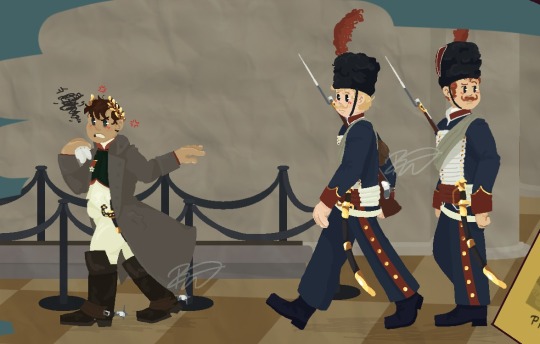
Étienne Champenois belongs to @lidensword and Gustave Bréant belongs to @all-yn-oween
Frank, Al, Ralph
#NATM#natm au#night at the museum ocs#night at the museum#Night at the museum 2#Night at the museum battle of the Smithsonian#NATM 2#napoleon bonaparte natm#napoleon natm#Bonaparte natm#Napoleon fanart#Frosty's art#Apr. 3#2024#Apr. 2024#I'm in the airport leaving Chicago now#well... Im stuck in the airport#I've been here for 2 hours and I have to wait around another four#I've been delayed three times#I'm also working on Al now I wasn't able to finish him by today so heres Napoleon#I was originally saving him for last#Also Im really sorry if I got anything wrong#Napoleon isnt my main guy so I know less about him
102 notes
·
View notes
Text


Wilhelmine von Biron:
a. „Beautiful, scandalous, three-times divorcee! Not only exchanged over 600 letters with Sexy Slut Metternich, but also captivated him to such degree that her renewal of an old affair with Alfred Windischgraetz distracted Metternich at a critical stage in the negotiations. Distracted! Metternich! At a critical stage!”
Zofia Czartoryska-Zamoyska:
a. „MY GIRLIEEEE… I love her more than anything, and I'm very sorry for how her relationship with her husband turned out (he was not abusive, perhaps, and treated her with some sort of basic respect, but he had a rough childhood and became emotionally neglectful, both towards her and the children. He did care for her, however it showed much more after she died and he was alone then when she was alive and well). She was actually considered one of the most beautiful, if not the most beautiful woman in the Warsaw Duchy, and was literally worshipped by her descendants. Her portrait even made an appearance as the male lead's unhappy grandmother in "Trędowata" (well, the book the movie was based on is not exactly wonderful literature, but the movie itself is quite well-known), and I can absolutely see why. She had such beautiful eyes. Also, she was a philanthropist and helped organise one of the first concerts of Fryderyk Chopin when he was a child to raise money.”
#napoleonic sexyman tournament#i keep using that portrait of Zofia because i love her romantic fairy aesthetic
47 notes
·
View notes
Text

Portrait of Maria Mirska, Barbara Szumska and Adam Napoleon Mirski
Jan Rustem (Armenian, 1762-1835), c. 1808, Napoleonic era
#paintings from the duchy of Warsaw#duchy of Warsaw#Jan Rustem#Rustem#art#art history#paintings#Portrait of Maria Mirska Barbara Szumska and Adam Napoleon Mirski#napoleonic era#napoleonic#Poland#polish art#Warsaw#first french empire#french empire#19th century#history#france#1800s#19th century art
25 notes
·
View notes
Text

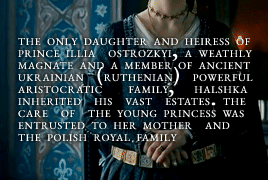


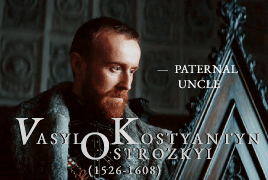
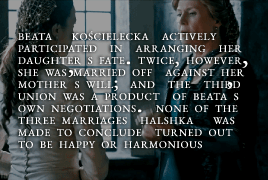

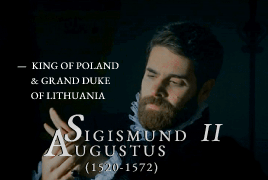
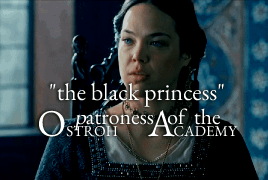
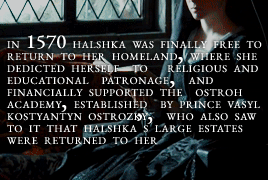
— 19th of NOVEMBER 1539, birth of HALSHKA (Elyzaveta, Elżbieta) OSTROZKA (OSTROGSKA), "the Black Princess"
Born on feast day of St. Elizabeth, she was christened Elżbieta, Elyzaveta, or Halshka (under this latter name she came down into history). Halshka’s father was Prince Illia Ostrozkyi (Ostrogski), a weathly magnate and a member of ancient Ukrainian (Ruthenian) powerful aristocratic family, that traced their origins back to the semi-legendary prince Rurik. The representatives of this family held great offices in the Grand Duchy of Lithuania and the Kingdom of Poland. At the royal court in Krakow, Illia Ostrozkyi met Beata Kościelecka, a notable beaty, and, according to the rumours, an illegitimate daughter of King Sigismund I of Poland. The couple was married in 1538, but their happiness did not last long: Illia was wounded during the tournament, and died soon after, in August 1539. In November Beata gave birth to their only child, a daughter.
According to her father’s will, Halshka stood to inherit half of his vast estates (including the cities of Ostroh and half of Rivne, along with many more), that were to be under her mother’s control until the heiress reached adulthood. Beata was also to keep control of her husband’s younger half brother’s Vasyl’s inheritance. The latter, who was to become powerful magnate and patron of religion and education under the name of Vasyl Kostyantyn Ostrozkyi (Ostrogski), soon took measures to retain the power of his estates his estates and rule them on his own. In his testament, Illia had also entrusted the care of his daughter to the King Sigismund, his wife, Queen Bona Sforza, and their son, Sigismund II Augustus.
Since Halshka was the recipient of such a magnificent inheritance, it soon became a matter of almost national importance to find her a suitable husband. Here, the interests of Lithuanian and Polish nobility also clashed. Suitors, eager for wealth and influence were not slow to appear. Among them were Dymitr Sanguszko, starost of Kaniv, Cherkasy and Zhytomyr, Jan Mielecki, voivode of Podilia, and even, according to a legend, Dmytro Vyshnevetskyi, the famous founder of the first stronghold on the Khortytsya island. Halshka’s uncle, Vasyl Kostyantyn Ostrozkyi, who was gradually growing in power, supported the candidature of Dymitr Sanguszko, while both the King of Poland and Beata Kościelecka were against him. Sanguszko married Halshka all the same, but was soon sentenced to infamy (deprivation of noble status and threat of death sentence if he did not agree to annul his marriage), and murdered.
The next match for Halshka, proposed by the King Sigismund II, was Łukasz Górka, voivode of Poznań, Kalisz, Łęczyca and Brześć Kujawski. Beata Kościelecka had at first agreed to it but later changed her mind towards this marriage. Once again, her protests availed nothing: the wedding took place in the presence of the royal family in Warsaw. Halshka was told that her mother agreed to the marriage, but when she learned that this was not the case, Princess appealed to the royal council to annul it, and fled to Lviv with Beata.
Halshka’s third union was orchestrated by Beata. This time the groom was Prince Siemion Slutski, who, for the sake of conspiracy, had to meet his bride in a monastery disguised as beggar. The couple wed in 1559, but this marriage was also short-lived. Though neither Halshka nor Beata regarded Łukasz Górka as the Princess’s true husband, Górka himself was evidently of different opinion. He rushed to Lviv with arms and took Halshka captive. Prince Siemion Slutski died in 1560. Górka placed Halshka – virtually a prisoner – in the castle of Szamotuły, near Poznań, where she spent fourteen years until his death, isolated from the world. It is said that during her imprisonment Halshka was wearing the black mourning robes, which was why she got nicknamed “the Black Princess”.
After the death of Łukasz Górka in 1573, Halshka Ostozka was finally free and able to return to her homeland. During the reign of Henri Valois as the King of Poland, Halshka’s uncle, Vasyl Kostyantyn Ostrozkyi saw to it that the estates, left to her by her father, were returned to the Princess. The rumours that Halshka has got insane during her confinement in Szamotuły, do not seem to be true, as in her later years she actively participated in the works of patronage, attended court hearings, and financially supported a prominent educational institution – the Ostroh Academy, established by Prince Vasyl Kostyantyn Ostrozkyi. She died in 1582, leaving her estates to Vasyl Kostyantyn.
Halshka Ostozka was said to be a remarkable beauty, but sadly none of her life portraits survived. She is featured in famous painting Kazanie Skargi (Sermon of Piotr Skarga, painted in 1862-64) by Jan Matejko, where Halshka is depicted as a young richly dressed woman, covering her forehead with her hand in sad contemplation; she is placed a little behind Anna Jagiellonka, sister to Sigismund II, and once Queen of Poland.
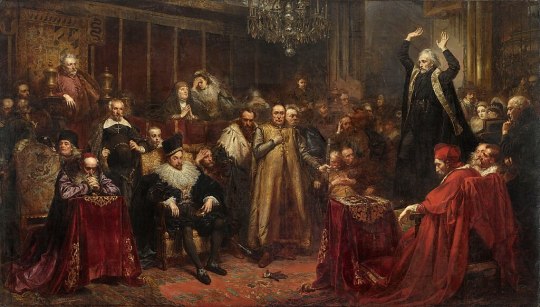
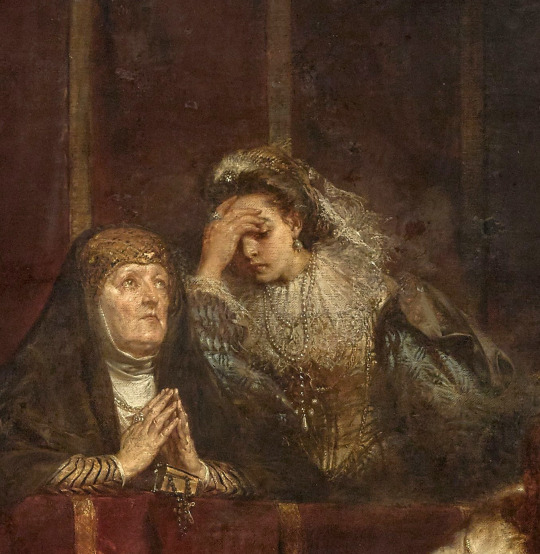

Another renown portrait of Halshka Ostrozka was painted in 1996 by Ukrainian artist Yurii Nikitin, who did a research among the portraits of Ostrozky family. The portrait features a young serious woman with delicate features, dressed in strict black gown, adorned with rich jewels, and a white headwear that covers her hair and neck closely. In her hand she is holding a book – most likely a Holy Scripture.
#historyedit#history#halshka ostrozka#elzbieta ostrogska#ukrainian history#polish history#perioddramaedit#sigismund i of poland#sigismund ii augustus#vasyl kostyantyn ostrozkyi#jan matejko#yurii nikitin#perioddramagif#women in history#weloveperioddrama#gifshistorical#tusereliza#userfefa#perioddramasource#my edit#not to be unhumble but i'm so proud of myself for making this edit
122 notes
·
View notes
Text
On this Day: Vienna Congress Edition
April 3rd, 1815
Political
Meeting of the "The Five".
The Duchy of Warsaw united with Russia
Mainz and Hanau become Confederation strongholds.
Other
A concert of Joseph von Szalay in the of the Zinn römischen Kaiser hotel.
7 notes
·
View notes
Text
The last letter gave me an idea...
Alright, I got some help regarding this "shipment" stuff—don't even know half of these guys—but this is a trend, apparently! I don't understand it much but it sounds kinda funny...
...Ey, none of you tell the old man I'm doing this, alright?
#dépêches personnelles#event - 𓄿#[[would the non-Davout simps know some of these guys/gals at all]]#[[one way to find out]]#[[I bloody forgot potocka. 💔]]
22 notes
·
View notes
Text
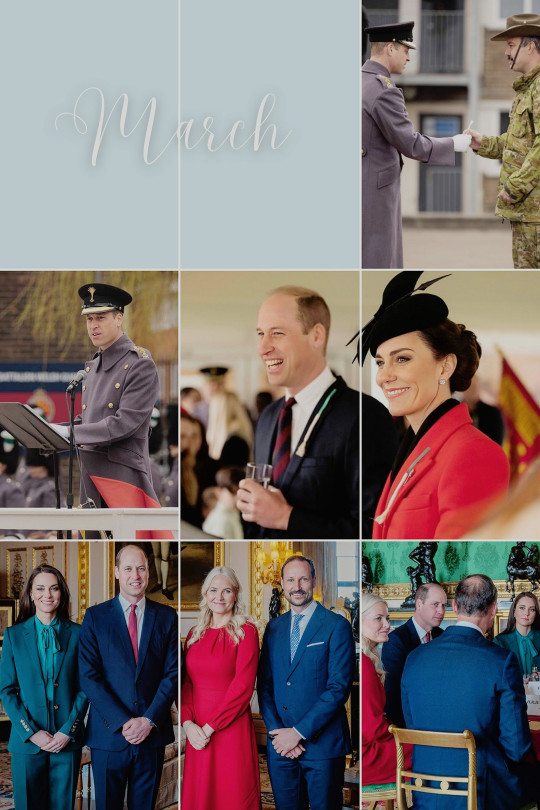
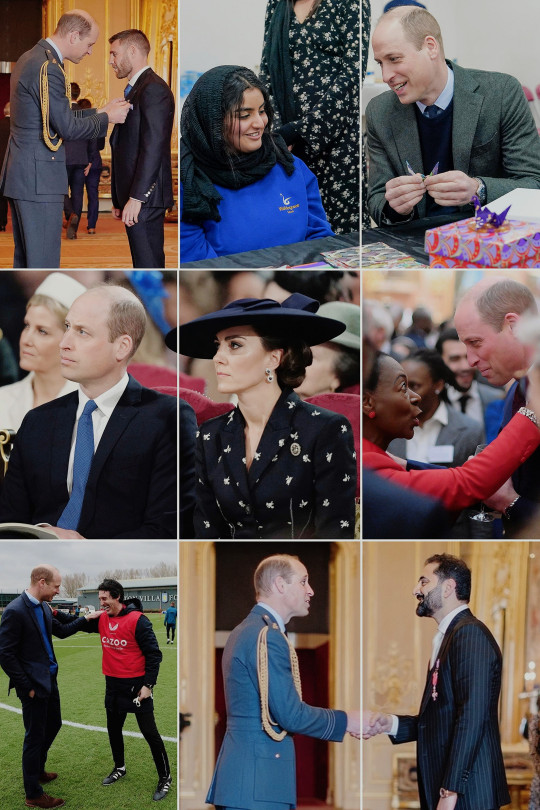
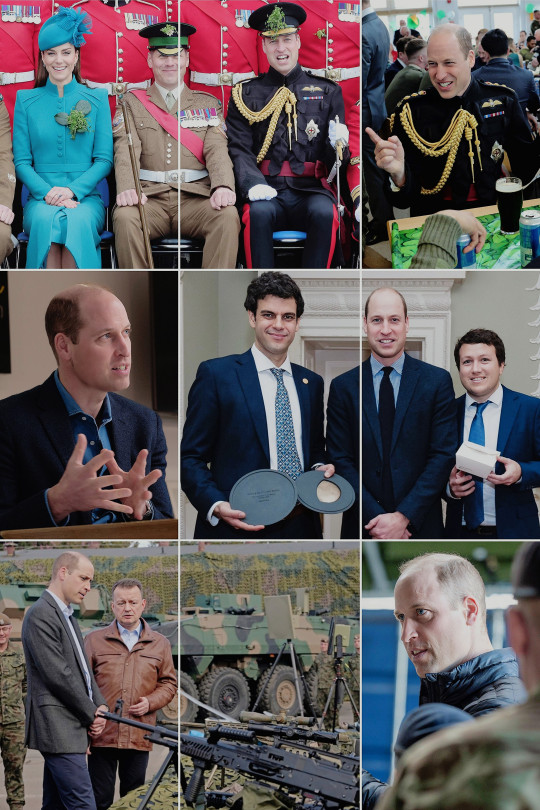

─ •✧ WILLIAM'S YEAR IN REVIEW : MARCH ✧• ─
1 MARCH - William was accompanied by Catherine for presenting Leeks to the Welsh Guards during the 1st Battalion Welsh Guards St. David's Day Parade at Combermere Barracks. 2 MARCH - William and Catherine received The Crown Prince and Princess of Norway at Windsor Castle. They later held a Meeting with Norwegian business delegates accompanied by the Crown Prince Couple. 6 MARCH - He chaired a Meeting of The Prince's Council. 7 MARCH - William held an Investiture at Windsor Castle. 9 MARCH - William and Catherine were received by Ms. Manju Malhi (Deputy Lieutenant of Greater London) at the Hayes Muslim Centre in Middlesex. 10 MARCH - He received Ms. Hannah Jones (Chief Executive, Earthshot Prize) at Windsor Castle. 13 MARCH - William and Catherine attended the Commonwealth Service in Westminster Abbey. Afterwards, he attended the Commonwealth Day Reception at Buckingham Palace. 14 MARCH - William held a Meeting at Windsor Castle. 16 MARCH - William held an Investiture at Windsor Castle. Afterwards, he visited Aston Villa FC at Bodymoor Heath. 17 MARCH - William accompanied Catherine in presenting Shamrocks to Irish Guards as they attended the 1st Battalion Irish Guards' St. Patrick's Day Parade in Aldershot. He appeared in a TV special with Groundswell for Red Nose Day. 19 MARCH - William wrote a letter to Alpha United Juniors condemning the incidents of racism being faced by their players. 20 MARCH - He received Mr. Alastair Martin (Secretary of the Duchy of Cornwall) at Windsor Castle. 21 MARCH - William held a Meeting with Rodrigo Garcia Gonzalez & Pierre-Yves Paslier (Founders, NotPla) 22 MARCH - William departed Royal Air Force Northolt for Poland where he was by His Majesty's Ambassador to the Republic of Poland (Her Excellency Ms. Anna Clunes) upon arrival at Rzeszow-Jasionka International Airport. He met British troops at the Airport. Afterwards, he visited a Rzeszow Military Base in and visited British troops providing support to Poland and Ukraine. Subsequently, William met Ukrainian refugees living in temporary accommodation in Warsaw. In the evening, he was spotted at Butero Bistro having dinner. 23 MARCH - William laid a wreath at the Tomb of the Unknown Soldier at Plac Marszalka Józefa Pilsudskiego and called upon The President of the Republic of Poland at the President's Chancellery. Afterwards, he met Ukrainian refugees at Hala Koszyki. Subsequently, subsequently he met Ukrainian staff from the British Embassy in Kyiv at Hala Koszyki. After completing his visit to Poland, William arrived at the Royal Air Force Northolt from Poland. 24 MARCH - William approved the appointment of the High Sheriff of Cornwall (Mr Toby George Howell Ashworth)
#british royal family#british royals#royalty#brf#royals#royal#british royalty#duke of cambridge#prince of wales#the prince of wales#prince william#royaltyedit#royalty edit#year in review 2023 : catherine#year in review : 2023#william review : march#year in review : william#review 2023#review march#kate middleton#catherine middleton#duchess of cambridge#princess of wales#the princess of wales#princess catherine#princess kate#my photoset#my edit
45 notes
·
View notes
Text
Józef Poniatowski’s women.
Part V. The rest of ladies who might have been of some interest to him
Good day everyone and let me share with the rest of information I possess on Prince Poniatowski's love interests. (Though, I have to admit, the ladies from this list were the least likely - from all the mentioned in these series of post - to have some kind of affair with Pepi.
To start I would like by Louise of Mecklenburg-Strelitz, the queen of Prussia.
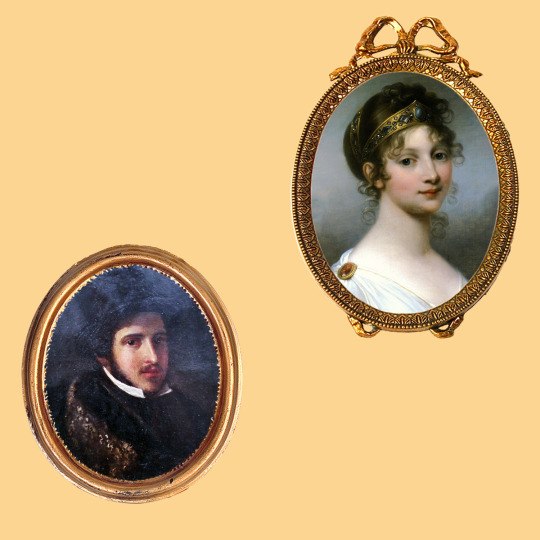
On the right - unidentified artist, miniature portrait of Prince Poniatowski, 19th century. On the left - portrait of Queen Louise by Giuseppe Grassi, 1802.
Prince Józef had the opportunity to meet the wife of the king Frederick William III at least four times, because the royal couple visited Warsaw - which had become a part of Prussia as a result of the third partition of Poland - three times, in 1798, 1802 and 1805. And in 1802 Poniatowski himself had to go to Berlin, to settle the matter of the inheritance left by his uncle Stanisław August.
According to Juliusz Fałkowski, while at Warsaw Prince Józef "…gave a ball and a dinner in the Copper-Roof palace in their honor [the King and Queen of Prussia - A.S.] and was flirting with the Queen everywhere", for which he received the star of the black eagle, although he rather "expected something else from the beautiful queen." After the departure of the royal couple, "he longed a little for the crowned beauty who had easily won his heart in passing."
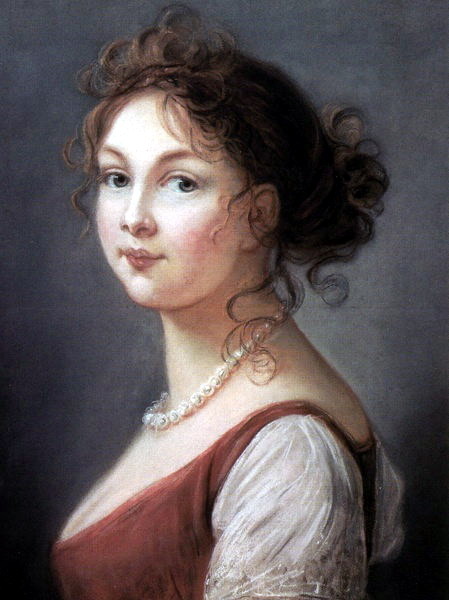
An Elisabeth Vigée-Lebrun painting of Queen Louise, c. 1801
The second source that mentions the relationship between these two is the book by Marian Brandys "Kozietulski i inni", which states (without giving sources, unfortunately) that during Pepi's visit to the capital of Prussia "… it was also said that the beautiful Queen Louise fell in love with in a knightly Pole."
However, if you ask my opinion about the likelihood of an affair between Pepi and the Queen of Prussia, I will say that in my opinion he was "flirting" her to make it easier to solve the inheritance problem. As for the fact that she could also be in love with the prince, I have no opinion because my knowledge about Queen Louise is not very great.
The second lady in today's list will be prince Józef's first cousin once removed, Anetka Potocka (née Tyszkiewicz, the daughter of Konstancja Poniatowska and a grand-daughter of prince Kazimierz, the oldest of the Poniatowski siblings).
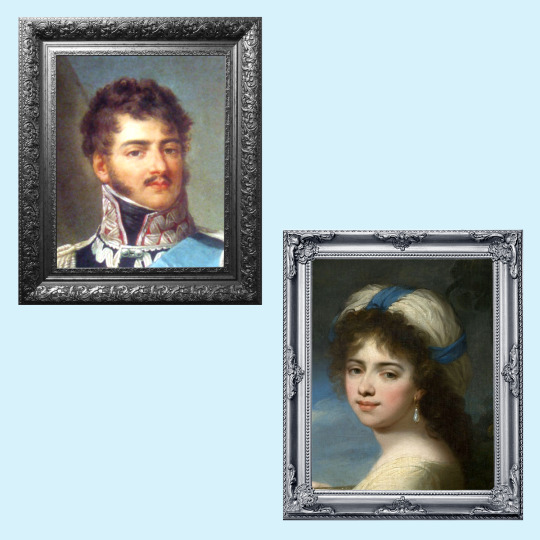
On the left - Poniatowski's portrait by Franciszek Paderewski, on the right - Portrait of Anetka Tyszkiewiczówna, Giuseppe Grassi, 1796.
Born in 1779, she was 16 years younger than Pepi, and she remained unmarried for quite a long time, becoming the wife of the Count Aleksander Potocki in 1805. (Marian Brandys, in the biography of Anetka's uncle prince Stanisław, states that some time before 1791 there was an idea to join all the Poniatowski estates marring Stanisław to his niece, but it was eventually abandoned.) The marriage brought them three children, but after 16 years Anetka asked for divorce and then wedded Colonel Stanisław Dunin-Wąsowicz. During the times of the Duchy of Warsaw, she was a frequent guest at the Copper Roof Palace, visited Paris, witnessed Napoleon's sojourns in Warsaw, with all of those events been described later in her memoirs.
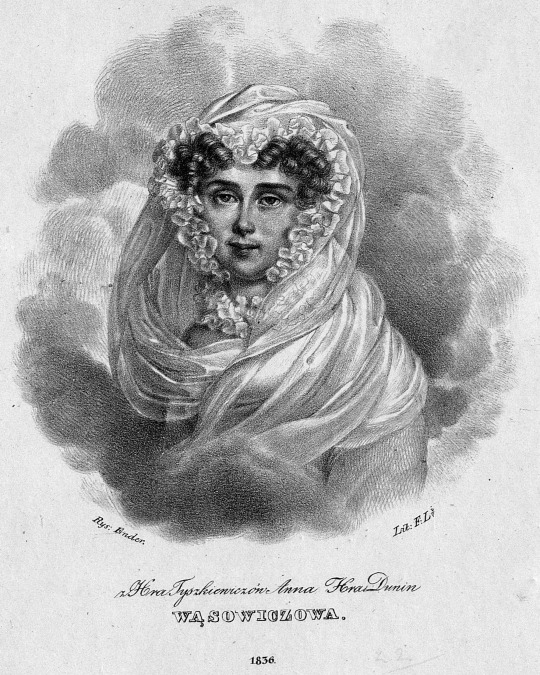
Portrait of Countess Dunin Wąsowicz, Anna née Tyszkiewicz, 1836.
As for her relationship with Prince Józef, it were her own words that made Fałkowski write that "the beautiful prince fell in love with Anetka" although "it was a platonic feeling".
"… Mrs. Aleksandrowa (Anetka Potocka - AS ) herself half-admitted thisin her old age. ''On disait alors que le Prince Joseph avait pour moi un sentiment plus tendre que l'amitié (it was said that Prince Joseph had for me a feeling more tender than friendship),' she would recalled with a dreamy expression on her face."
The second thing that leads historians to believe that Pepi could have distinguished this cousin of his from other relatives is the provision in his will, according to which she was to receive, after the death of the prince's sister, Teresa Tyszkiewicz, his favorite palace in Jabłonna near Warsaw. And when this did happen, Anetka ordered a triumphal arch to be built in the park in memory of Prince Józef.

The palace in Jabłonna, 2019
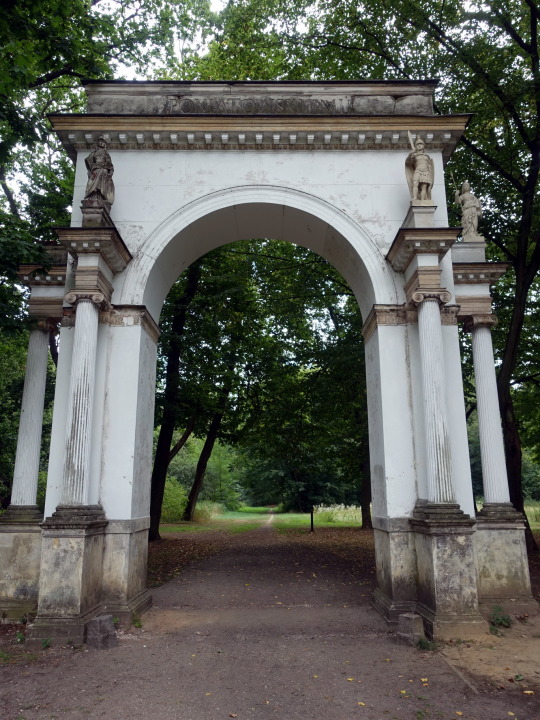
The triumphal arch from Jabłonna's park, 2019
And collage of mine is an illustration to the part dedicated to the rest of the women, whose portraits I wasn't able find. And honestly, the evidence that they might have been Prince Józef's love interests is very weak. But, since historians from time to time do mention these ladies' names, I thought them worth being included as well…
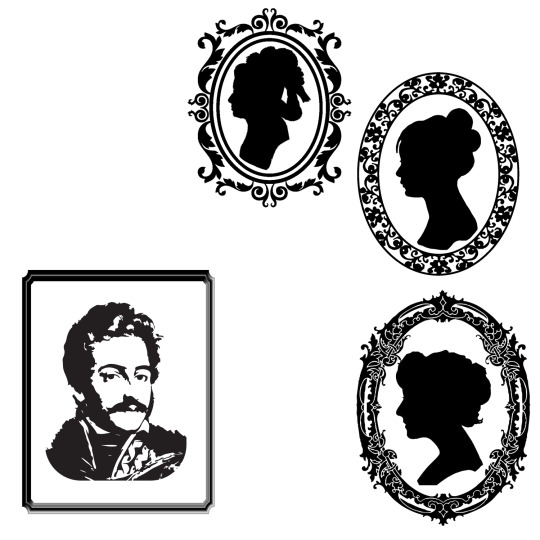
For example, in the prince's testament, together with Henriette de Vauban, Zofia Czosnowska and the above mentioned Anetka Potocka, there was mentioned Elżbieta Merlini, the daughter of Dominique Merlini, an Italian architect, the last main builder of the Polish-Lithuanian Commonwealth. But such concern for the architect's daughter may have been explained by a sense of moral debt to her father, which the prince Józef inherited from King Stanisław with the rest of the things.
Then, the list of Pepi's women sometimes complemented by another "Elżbieta" - Cichocka (although her real names were Emilia Karolina - or Katarzyna) née Bachmińska I° voto Szymanowska, II° voto Cichocka, III° voto Abramowiczowa. It is said she even sojourned in Jabłonna before 1810, until being apparently forced by Zofia Czosnowska to leave the place. After that Madame Cichocka went to Vilna, where she married her third husband. However, what IMHO should be taken into account in regards with this lady is that her second husband, Michał Cichocki, was an illegitimate son of Stanisław August, which might have made Prince Józef consider her a relative and thus take care about.
The same can be said about Madame Kicka - Józefa Martyna Rozalia née Szydłowska, who was a sister of Elżbieta Grabowska, another mistress of King Stanisław.
Sometimes the names of women who were friends and companions of Madame de Vauban are also included to the list of prince Józef's love interests. Those are: Anna Krasińska, a relative of general Krasiński and the wife of Mikołaj Oppeln-Bronikowski; Salomea Wielhorska née Dembińska; Anna Trębicka née Czerska, future wife of general Kamieniecki, and Józefa Potocka née Sollohub.
PS. As the regular visitors to the Copper Roof Palace are as well mentioned two ladies of the surname Walewska: Józefina née Lubomirska, the wife of Adam Walewski and the future wife General Witt, and Maria, the wife of Anastazy Walewski. The first of them was known for her kind of loose behavior, so presumably she might have at least flirted with Pepi; the second one is the famous Maria Walewska, but all I know about her makes me think her love for the emperor left no room in her heart for other men.
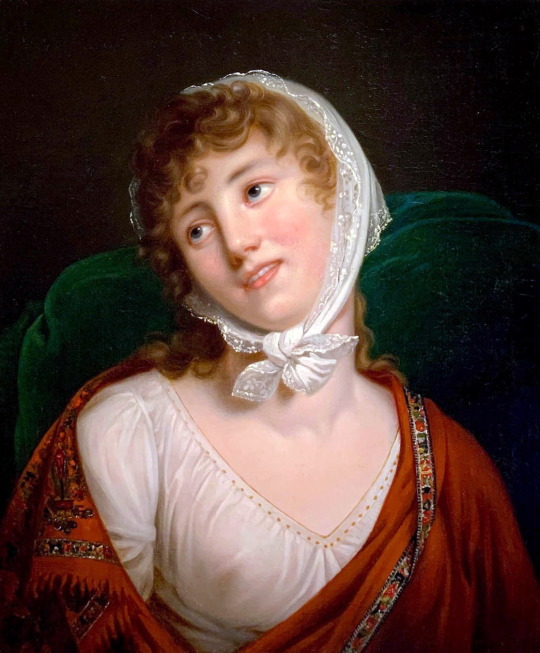
Portrait of Maria Walewska by Robert Lefèvre
#poniatowski#józef poniatowski#józef poniatowski’s women#queen Louise of Prussia#Giuseppe Grassi#Anetka Potocka#Jabłonna#Jabłonna palace#Maria Walewska#Robert Lefèvre
13 notes
·
View notes